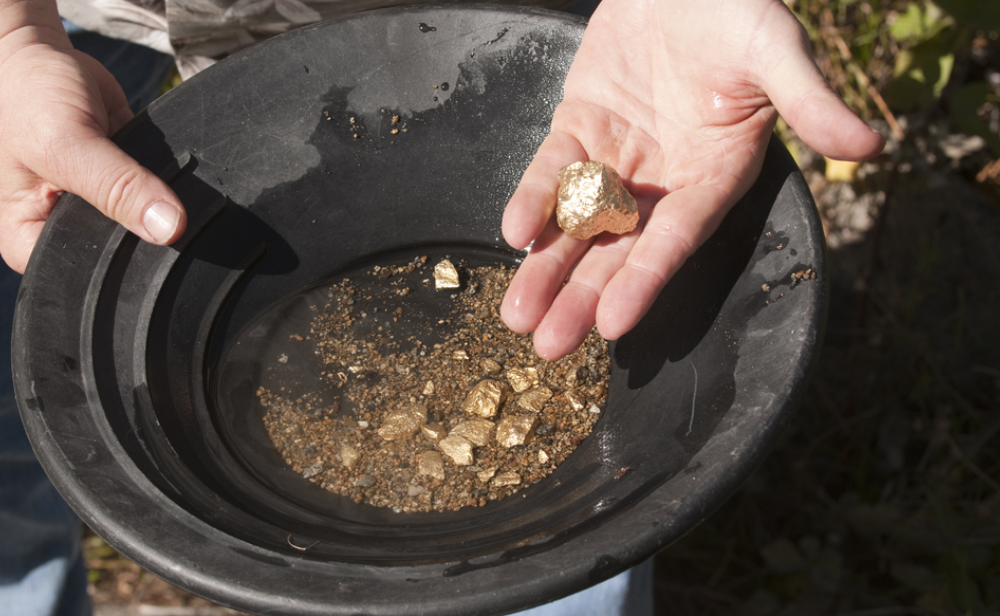
Seeking gold doesn’t have to be challenging for a novice gold prospector. In reality, all that is needed to get started is a shovel and a gold pan. All the other equipment is purely optional, and having it will only make someone a better gold prospector. It may sound not easy, as one can imagine learning how to pan for gold. British Championships are held every year to compete for the British Gold panning Champion title. Although panning in a river may seem a little dull for some, it is incredibly rewarding if done with proper planning. However, competitive panning is a very different affair where the objective is speed.
Process:
Step 1
The first step is to locate a deep enough spot in the creek, be it a stream or river, to completely submerge the gold pan. If one can locate, a location chosen should be fast to move water to carry away the soggy mud being dugout. Continuous rests in the middle of work will be necessary considering the energy being used for this hectic work. It will be a lot more comfortable in the long run.
Step 2:
The gold pan is filled 2/3 with the unwashed gold. It is better not to fill the gold pan with unwashed gold and soggy mud, as it can become too heavy and take too long to pan completely. The second step involves submerging the unwashed gold pan into the water and mixing up the gravel with fingers. The unwashed gold is separated into volumes of two densities by doing this. The rocks and gold of heavier density settle down in the pan while the soggy mud floats on the water’s surface.
Step 3:
The process mentioned above helps remove all the large rocks from the pan. The third step involves removing the minute amount of dirt stuck in the edges of the sharp ends of rocks to cleanse it completely. Again with the help of fingers, the material is mixed, removing more large rocks. Now begins the step where the gold pan is shaken from side to side. It will be better to shake the gold pan vigorously to settle the material. However, enough care should be given to not spill the gravel out of the pan.
Step 4:
In this step, the material is swirled around in the gold pan in a circular motion, keeping the pan just under the water’s surface. By doing this, the lighter gravel comes to the surface while the heavier one settles down. The pan is then tilted forward and rotated again, allowing the lighter sand and gravel to wash out over the front edge. Be sure the riffles are at the front of the gold pan, and the material is washing out over them, so they can begin to help trap the gold. This process continues until only a small amount of the lighter material is left, along with the heavier black sands. Sand and gravel sink to the bottom of the pan.
Step 5:
The gold pan is taken out of the stream; however, about an inch of water covering the material is left. Carefully swirling the material around in the pan will help see any gold or silver at this point which is taken to tip the pan while the heavier material is shaken into one side of the pan. This heavier material present on one side of the pan is given a couple more shakes. The pan is submerged back in the water, and the process is repeated, gently washing away any more of the lighter material left in the pan. The pan is taken out again, keeping about an inch of water. Here, the water is swirled gently over the sand, which removes a top layer each time. This is where small gold flakes in the black sand become visible.
Economy of Gold
Due to the high demand for gold, selling some accumulated gold is quite easy. First, we looked into various ways of selling it. Taking it to a jewelry store is one way. Many of them buy gold, though the price for the gold brick is way below the market value. People use sites like eBay, where they sell gold bricks on eBay and get decent prices. Also, gold bricks are sold at local auction houses where a special local auction house sells and specializes in many expensive gold coins and jewelry; hence, due to increased demand, a high price is paid for these gold bricks.
People have trouble selling all their hard-won gold. They keep some for the souvenir value, and as a reminder of all the locations, they have gone along with the hard work they put in to mine it. The weighing includes nuggets, flakes, and dust, sealed in a new plastic vial with a little description of the contents written on it, sold in auction houses. The unsold remains include smaller gold bricks, flakes, or even granular gold. These are all packed up in plastic bags and weighed carefully. This involves the usual technique of weighing the plastic bag initially and then cutting out its weight from when it was weighed full of gold remains.
Conclusion
Gold panning is a fun-worthwhile interest that allows the possibility of getting high-cease advantages. Going in groups to pan gold on the locations makes it more fun and less tiring. It also exposes the wild nature, be it creeks, rivers, lakes, or streams of water. So even if we come back empty-handed with failed efforts, the journey is still worthwhile and rejuvenating! In other words, people had been capable of making widespread quantities of cash by simply stepping into the wild nature! Others have modified their lives cash-wise. The bottom line, gold panning is worth it, considering the products it brings to the table!
